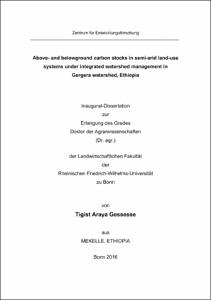Gessesse, Tigist Araya: Above- and belowground carbon stocks in semi-arid land-use systems under integrated watershed management in Gergera watershed, Ethiopia. - Bonn, 2016. - Dissertation, Rheinische Friedrich-Wilhelms-Universität Bonn.
Online-Ausgabe in bonndoc: https://nbn-resolving.org/urn:nbn:de:hbz:5n-44339
Online-Ausgabe in bonndoc: https://nbn-resolving.org/urn:nbn:de:hbz:5n-44339
@phdthesis{handle:20.500.11811/6621,
urn: https://nbn-resolving.org/urn:nbn:de:hbz:5n-44339,
author = {{Tigist Araya Gessesse}},
title = {Above- and belowground carbon stocks in semi-arid land-use systems under integrated watershed management in Gergera watershed, Ethiopia},
school = {Rheinische Friedrich-Wilhelms-Universität Bonn},
year = 2016,
month = dec,
note = {Enhanced carbon stocks help to improve the productivity and resilience of farming systems, especially in smallholder communities relying on subsistent agriculture. This study investigated the total terrestrial stock of organic carbon and its controlling factors in prevalent land-use systems in the Gergera watershed, northern Ethiopia, as part of the impact assessment of the integrated watershed management (IWM) program introduced in the region.
Land-use and land-cover change (LULC) over 20 years (1994-2014) were analyzed using Landsat remote sensing imagery and a random forest algorithm. Above- and belowground biomass and soil were sampled from four major land-use systems, i.e. exclosures, croplands, rangelands and bare land. The soil samples collected at four slope positions, i.e. ridge, backslope, footslope and valley bottom and from four depth intervals (0-15, 15-30, 30-60 and 60-100 cm) were analyzed for organic carbon (SOC), bulk density, rock fragment, and other physical and chemical parameters. Soil cesium-137(137Cs) was analyzed to trace the pattern of SOC distribution in the watershed.
The LULC change analysis indicates an improved vegetation cover since the adoption of IWM due to conversion from cropland to forest land and from bare land to rangeland on 3.3% and 6.3 % of the watershed area, respectively. Reduced vegetation cover is also observed due to changes of cropland to bare land and forest land to rangeland on 3.5% 5.7% of the area.
The field survey revealed significantly higher aboveground carbon stock in the plant biomass of exclosures (9.08(±1.44) Mg C ha-1) followed by croplands and rangelands with 3.16(±0.24) Mg ha-1 and 1.49(±0.18) Mg ha-1, respectively. The belowground biomass carbon content is particularly low in the croplands (0.76(±0.09) Mg ha-1), exceeded by that in the exclosures and rangelands where values average 3.67(±0.06) Mg ha-1 and 3.16 (±0.39) Mg ha-1, respectively. The total terrestrial carbon stocks differ according to the land use systems in the ranked order of exclosures (55.6.11(±4.89) Mg ha-1) ≈ rangelands (53.77(±4.4) Mg ha-1) > croplands (31.69(±3.99) Mg ha-1) ≈ and bare land (35.52(±6.47) Mg ha-1). Besides the land use type, the SOC stock in the examined land-use systems is found negatively related to the content of coarse fragments and bulk density of the soil, which both measured the highest values in croplands and exclosures. Topsoils had greater SOC in all land use systems but the deeper soils (30-100cm) still contained 36 % of the SOC stock.
The pattern of 137Cs distribution in the watershed generally indicates the presence of erosion, mostly on backslopes of exclosures and rangelands. However, the positive significant correlation between 137Cs and SOC distribution in exclosures points at a build-up of SOC.
The overall results of the study highlight that more efforts in application of improved soil management practices are still required to enhance the current status of the SOC pool, particularly in the croplands, and thereby sustain the land productivity.},
url = {https://hdl.handle.net/20.500.11811/6621}
}
urn: https://nbn-resolving.org/urn:nbn:de:hbz:5n-44339,
author = {{Tigist Araya Gessesse}},
title = {Above- and belowground carbon stocks in semi-arid land-use systems under integrated watershed management in Gergera watershed, Ethiopia},
school = {Rheinische Friedrich-Wilhelms-Universität Bonn},
year = 2016,
month = dec,
note = {Enhanced carbon stocks help to improve the productivity and resilience of farming systems, especially in smallholder communities relying on subsistent agriculture. This study investigated the total terrestrial stock of organic carbon and its controlling factors in prevalent land-use systems in the Gergera watershed, northern Ethiopia, as part of the impact assessment of the integrated watershed management (IWM) program introduced in the region.
Land-use and land-cover change (LULC) over 20 years (1994-2014) were analyzed using Landsat remote sensing imagery and a random forest algorithm. Above- and belowground biomass and soil were sampled from four major land-use systems, i.e. exclosures, croplands, rangelands and bare land. The soil samples collected at four slope positions, i.e. ridge, backslope, footslope and valley bottom and from four depth intervals (0-15, 15-30, 30-60 and 60-100 cm) were analyzed for organic carbon (SOC), bulk density, rock fragment, and other physical and chemical parameters. Soil cesium-137(137Cs) was analyzed to trace the pattern of SOC distribution in the watershed.
The LULC change analysis indicates an improved vegetation cover since the adoption of IWM due to conversion from cropland to forest land and from bare land to rangeland on 3.3% and 6.3 % of the watershed area, respectively. Reduced vegetation cover is also observed due to changes of cropland to bare land and forest land to rangeland on 3.5% 5.7% of the area.
The field survey revealed significantly higher aboveground carbon stock in the plant biomass of exclosures (9.08(±1.44) Mg C ha-1) followed by croplands and rangelands with 3.16(±0.24) Mg ha-1 and 1.49(±0.18) Mg ha-1, respectively. The belowground biomass carbon content is particularly low in the croplands (0.76(±0.09) Mg ha-1), exceeded by that in the exclosures and rangelands where values average 3.67(±0.06) Mg ha-1 and 3.16 (±0.39) Mg ha-1, respectively. The total terrestrial carbon stocks differ according to the land use systems in the ranked order of exclosures (55.6.11(±4.89) Mg ha-1) ≈ rangelands (53.77(±4.4) Mg ha-1) > croplands (31.69(±3.99) Mg ha-1) ≈ and bare land (35.52(±6.47) Mg ha-1). Besides the land use type, the SOC stock in the examined land-use systems is found negatively related to the content of coarse fragments and bulk density of the soil, which both measured the highest values in croplands and exclosures. Topsoils had greater SOC in all land use systems but the deeper soils (30-100cm) still contained 36 % of the SOC stock.
The pattern of 137Cs distribution in the watershed generally indicates the presence of erosion, mostly on backslopes of exclosures and rangelands. However, the positive significant correlation between 137Cs and SOC distribution in exclosures points at a build-up of SOC.
The overall results of the study highlight that more efforts in application of improved soil management practices are still required to enhance the current status of the SOC pool, particularly in the croplands, and thereby sustain the land productivity.},
url = {https://hdl.handle.net/20.500.11811/6621}
}






